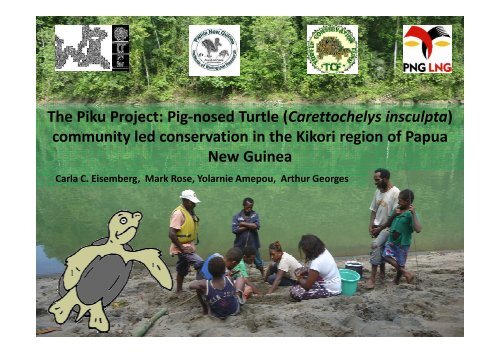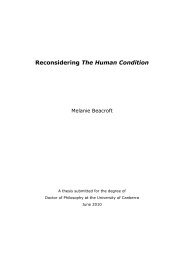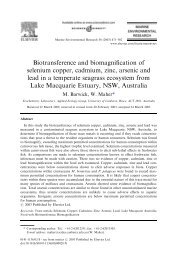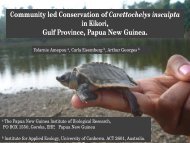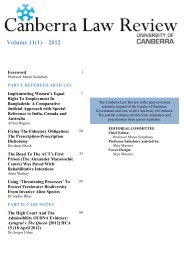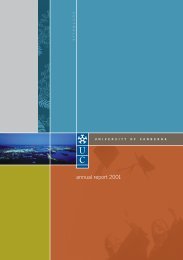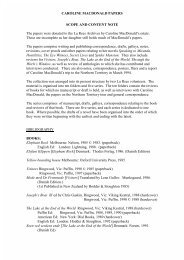The Piku Project: Pig-nosed Turtle (Carettochelys insculpta ...
The Piku Project: Pig-nosed Turtle (Carettochelys insculpta ...
The Piku Project: Pig-nosed Turtle (Carettochelys insculpta ...
Create successful ePaper yourself
Turn your PDF publications into a flip-book with our unique Google optimized e-Paper software.
<strong>The</strong> <strong>Piku</strong> <strong>Project</strong>: <strong>Pig</strong>-<strong>nosed</strong> <strong>Turtle</strong> (<strong>Carettochelys</strong> <strong>insculpta</strong>)<br />
community led conservation in the Kikori region of Papua<br />
New Guinea<br />
Carla C. Eisemberg, Mark Rose, Yolarnie Amepou, Arthur Georges
<strong>Pig</strong>-<strong>nosed</strong> turtle (Carettochelyidae)<br />
• Australia and New Guinea<br />
• Kikori River
Kikori<br />
<strong>Pig</strong>-<strong>nosed</strong> turtle<br />
– Important source of protein<br />
– Especially during the nesting season<br />
Krista Nash, 2011
Aims and objectives:<br />
<strong>Piku</strong> <strong>Project</strong> 2012<br />
• Phases:<br />
– 1 st phase: January and February<br />
– 2 nd phase: April<br />
• Cement in place a long-term community-led monitoring program<br />
for the markets and target villages.<br />
• Protect the main pig-<strong>nosed</strong> turtle nesting area in the Kikori River<br />
and use it as an example to bring interest to other sand bank land<br />
owners.<br />
• Bring awareness about conservation and management of wildlife:<br />
– “<strong>Piku</strong> on Radio” program<br />
– Children’s book “<strong>The</strong> Adventures of <strong>Pig</strong>gy on the Kikori River”
Building Capacity<br />
• Graduate students<br />
• University students<br />
• Kikori Secondary students<br />
• Workshops<br />
• Field experience<br />
Future master student Kikori students
Market Monitoring<br />
• Meat and eggs<br />
• 5 students from Kikori Secondary<br />
• 10 pig-<strong>nosed</strong> turtles sold<br />
• Kibeni, Veraibari, Apeowa and<br />
Wowou Villages<br />
• Delta and coastal villages<br />
• 90 eggs sold – Feb. to April<br />
• Waira Village<br />
• Upstream
Number of eggs<br />
10,000<br />
8,000<br />
6,000<br />
4,000<br />
2,000<br />
0<br />
Village Monitoring<br />
Kopi<br />
Waira<br />
1981-1982 2007-2008 2008-2009 2011-2012<br />
Nesting season
Sand Bank Protection<br />
• Wau Creek<br />
• Protected for 30 days - Jan 17 to<br />
Feb 15<br />
Nest fate (%)<br />
Between years (Wau Creek)<br />
70<br />
60<br />
50<br />
40<br />
30<br />
20<br />
10<br />
0<br />
2008-2009 2011-2012<br />
Nesting season<br />
Hatched<br />
Predated<br />
Harvested<br />
Unknown
Sand Bank Protection<br />
Results<br />
Number of nests<br />
12<br />
10<br />
8<br />
6<br />
4<br />
2<br />
0<br />
Between areas<br />
Flooded Hatched Predated Removed Unknown<br />
Nest fate<br />
Harvested?<br />
Inside<br />
Outside
Other activities
Next steps
Tanikiu bada herea!<br />
• Exxon Mobil staff<br />
– Stephen Whisker, Valentina Kaman, Eurelia Paine, Dylan Soondrawu, Justin<br />
Ondopa, Alphonse Nao, Serah Kende and Sisa Kini<br />
• PNG Department of Environment and Conservation<br />
– Dr Colin Filer (ANU) and Jim Robins (NRI)<br />
• From Kopi Camp<br />
– Floyd Robinson, Florence Sabo and Steve Dekene.<br />
• CDI Foundation staff<br />
– Cathy Alex, Peter John, Wapi Ekali and John Aitau<br />
• People from Kikori villages<br />
– Waira, Kopi, irimuku, Ero and Apeowa.<br />
• Frank John and his family for the protection of Wau creek and assistance<br />
in the field.<br />
• Students from Kikori Secondary School<br />
• <strong>The</strong> Papua New Guinea Institute of Biological Research.


